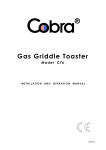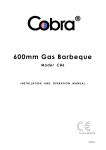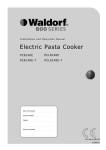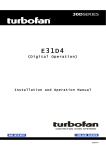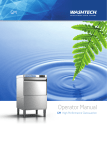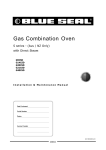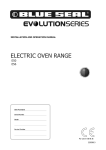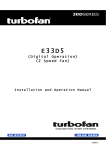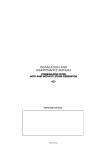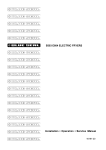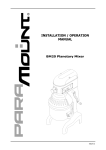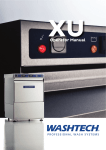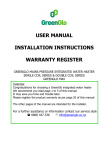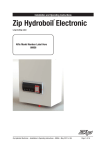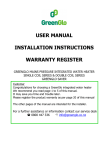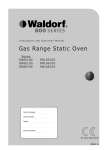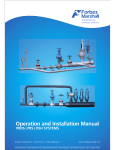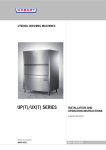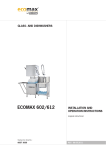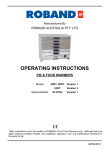Download User Manual - Comkit Online
Transcript
Electric Combination Oven S Series (Aus / NZ Only) with Direct Steam E9CSD E14CSD E20CSD E21CSD E40CSD Installation & Maintenance Manual 234861-1 MANUFACTURED BY Moffat Limited Christchurch New Zealand INTERNATIONAL CONTACTS AUSTRALIA Moffat Pty Limited E.Mail: Main Office: Service: Spares: Customer Service: [email protected] (tel) (03) 9518 3888 (fax) (03 9518 3833 (tel): 1800 622 216 (tel): 1800 337 963 (tel): 1800 335 315 (fax): 1800 350 281 CANADA Serve Canada Web: E.Mail: Sales: Service: www.servecanada.com [email protected] (tel): 800 551 8795 (Toll Free) (tel): 800 263 1455 (Toll Free) NEW ZEALAND Moffat Limited Web: E.Mail: Main Office: www.moffat.co.nz [email protected] (tel): 0800 663328 UNITED KINGDOM Blue Seal Web: E.Mail: Sales: Spares: Service: www.blue-seal.co.uk [email protected] (tel): 0121 327 5575 (fax): 0121 327 9711 (tel): 0121 322 6640 (fax): 0121 327 9201 (tel): 0121 322 6644 (fax): 0121 327 6257 UNITED STATES Moffat Web: Sales: Service: www.moffat.com (tel): 800 551 8795 (Toll Free) (tel): 336 661 1556 (fax): 336 661 9546 (tel): 800 858 4477 (Toll Free) (tel): 366 661 1556 (fax): 336 661 1660 REST OF WORLD Moffat Limited Web: E.Mail: www.moffat.co.nz [email protected] The reproduction or copying of any part of this manual by any means whatsoever is strictly forbidden unless authorized previously in writing by the manufacturer. In line with policy to continually develop and improve its products, Moffat Ltd. reserves the right to change the specifications and design without prior notice. © Copyright Moffat Ltd. June 2010. 234861-1 CONTENTS Page 1. INTRODUCTION 2 2. SPECIFICATIONS 4 3. INSTALLATION DIAGRAMS 5 4. SPECIAL REQUIREMENTS FOR THE INSTALLATION SITE 11 5. STATUTORY REQUIREMENTS, TECHNICAL REGULATIONS AND DIRECTIVES 12 6. POSITIONING 13 7. ELECTRICAL CONNECTIONS AND EQUIPOTENTIAL BONDING 14 8. POINTS TO REMEMBER WHEN MAKING THE ELECTRICAL CONNECTION 14 9. WATER AND DRAIN CONNECTIONS 15 10. VENTS 18 11. COMMISSIONING AND TESTING 18 12. IMPORTANT INFORMATION FOR THE USER 19 NOTES 20 MODELS ELECTRICAL E9CSD E14CSD E20CSD E21CSD E40CSD VERSIONS S - Programmable electronics with direct access key to the programs and recipes, automatic humidity control and lighting. The manufacturer accepts no liability for any inaccuracies in this manual attributable to printing or copying errors. We reserve the right to modify our products as we deem fit, without impairing their basic features. The reproduction or copying of any part of this manual by any means whatsoever is strictly forbidden unless authorized previously in writing by the manufacturer. 15.09.2008 234861-1 1 1 INTRODUCTION We are confident that you will be delighted with your Blue Seal Combi Oven, and it will become a most valued appliance in your commercial kitchen. To ensure you receive the utmost benefit from your new Blue Seal appliance, there are two important things you can do. Firstly Please read the instruction book carefully and follow the directions given. The time taken will be well spent. Secondly If you are unsure of any aspect of the installation, instructions or performance of your appliance, contact you BLUE SEAL dealer promptly. In many cases, a phone call could answer your questions. WARNING: GREAT CARE MUST BE TAKEN BY THE OPERATOR TO USE THE EQUIPMENT SAFELY TO GUARD IT AGAINST RISK OF FIRE. • • THE APPLIANCE MUST NOT BE LEFT ON UNATTENDED. IT IS RECOMMENDED THAT A REGULAR INSPECTION IS MADE BY A QUALIFIED SERVICE PERSON TO ENSURE CORRECT AND SAFE OPERATION OF YOUR APPLIANCE IS MAINTAINED. WARNING: DO NOT STORE OR USE GASOLINE OR OTHER FLAMMABLE VAPOURS OR LIQUIDS IN THE VICINITY OF THIS OR ANY OTHER APPLIANCE. DO NOT SPRAY AEROSOLS IN THE VICINITY OF THIS APPLIANCE WHILE IT IS IN OPERATION. WARNING: IMPROPER INSTALLATION, ADJUSTMENT, ALTERATION, SERVICE OR MAINTENANCE CAN CAUSE PROPERTY DAMAGE, INJURY OR DEATH. READ THE INSTALLATION, OPERATING AND MAINTENANCE INSTRUCTIONS THOROUGHLY BEFORE INSTALLING OR SERVICING THIS APPLIANCE. C AUTIO N : This appliance is for professional use and is only to be used by qualified people. 234861-1 2 1 INTRODUCTION Installations must be carried out by qualified persons only. Failure to install equipment to the relevant codes and manufacturer’s specifications shown in this section will void the warranty. Components having adjustments protected (e.g. paint sealed) by manufacturer are only allowed to be adjusted by an authorised service agent. They are not to be adjusted by the installation person. 1.1 The oven must be installed, commissioned and maintained only by a Blue Seal authorized service agent. 1.2 Carefully read the directions given in this manual; they contain important information on safety during installation, operation and maintenance. Keep this manual in a safe place for future consultation! 1.7 Before positioning and connecting the appliance, check that the utilities (electrical power and water supplies) are as indicated on the data plate. The data plate is on the right-hand side, at the bottom. 1.8 Example of a data plate:- 1.9 The positions of inlet and drain connections are clearly labelled. For further details, see the installation diagram in this manual. C AUTIO N : 1.10 In the event of breakdown or faulty operation, switch ‘Off’ the oven immediately! This appliance is for professional use and is only to be used by qualified personnel. 1.3 This appliance must be put only to the use for which it is specifically intended, i.e. cooking foods; any other type of use is improper and therefore dangerous. 1.4 Having removed the packing check that the appliance is not damaged in any way. If in doubt, proceed no further with installation of the appliance and contact the Blue Seal Customer Service or your dealer immediately. NOTE: If for some reason it is not possible to get the appliance to operate correctly, shut off the electrical supply and contact the supplier of this unit. 1.11 During installation and / or maintenance work it is recommended you wear gloves to protect your hands. 1.12 Safety sticker. 1.5 Packing materials are potentially dangerous and must not be left where children can play with them. 1.6 Packing materials must be disposed of in conformity with local regulations. This normally means that the different materials are sorted according to type and collected as urban refuse. • Maximum height for inserting containers with liquids. 234861-1 3 2 SPECIFICATIONS ELECTRIC OVENS (ExxCSD Series) TABLE 1: ELECTRICAL DATA Power Supply Frequency Total Power Input Amps @ 400Vac Motor 3P+N+E 50 Hz 9.5 kW 14 1 x 0.25 kW 400-415 V ac 3P+N+E 50 Hz 16 kW 23 1 x 0.55 kW E20CSD 400-415 V ac 3P+N+E 50 Hz 31 kW 45 1 x 0.55 kW E21CSD 400-415 V ac 3P+N+E 50 Hz 31.8 kW 46 2 x 0.55 kW E40CSD 400-415 V ac 3P+N+E 50 Hz 61.8 kW 89 2 x 0.55 kW Model E9CSD E14CSD Voltage Type 400-415 V ac Electrical Cable Requirements When connecting a Blue Seal electric appliance to the main supply, ensure that the following is carried out:• An isolating switch is fitted within 2m of the appliance, but not on the appliance and in such a position that the user does not have to reach across the cooking surface. • Supply cord shall be oil-resistant, sheathed flexible cable and not lighter than ordinary polychloroprene or other equivalent synthetic elastomer sheathed cord (as per AS/NZS 3191 part 2.10.11. or IEC 60245-IEC-57) e.g. H05 RN-F Type. • The branch supply line shall be individually overload protected to the correct current rating and the supply chord shall be protected against any mechanical or thermal damage. • A grommet is fitted around the wiring entry hole into the appliance. • All wiring connections must be tight. Refer to the appropriate wiring standards for the size of cable that is to be supplied to an appliance for the current drawn on that line. TABLE 2: GENERAL WATER DATA Water Pressure [kPa] Softened Water Consumption [max.l/h] Water Connection 200 - 500 15 2 x R 3/4" (1) 200 - 500 22 2 x R 3/4" (1) E20CSD 200 - 500 22 2 x R 3/4" (1) E21CSD 200 - 500 30 2 x R 3/4" (1) E40CSD 200 - 500 44 2 x R 3/4" (1) Model E9CSD E14CSD (1) The ovens are equipped with two water inlets, one for non-softened cold water and the other for hot water (max. 50 °C) or softened cold water. 234861-1 4 3. INSTALLATION DIAGRAMS E9CSD- Dimensions 234861-1 5 3. INSTALLATION DIAGRAMS E14CSD - Dimensions 234861-1 6 3. INSTALLATION DIAGRAMS E20CSD - Dimensions 3 INSTALLATION DIAGRAMS 234861-1 7 3. INSTALLATION DIAGRAMS E21CSD - Dimensions 234861-1 8 3. INSTALLATION DIAGRAMS E40CSD - Dimensions 234861-1 9 3 INSTALLATION DIAGRAMS DISTANCES TO OBSERVE We recommend keeping a distance of 500mm on the right-hand side in order to carry out maintenance work. DO NOT INSTALL APPLIANCES WITH A SOURCE OF HEAT ON THE RIGHTHAND SIDE OF THE OVEN C AUTIO N : If the ambient temperature to the right of the appliance is too high, the oven will stop for safety reasons. Minimum distance from sources of heat on the right-hand side: 400mm. 234861-1 10 4 SPECIAL REQUIREMENTS FOR THE INSTALLATION SITE Installation Requirements NOTE: • It is most important that this appliance is installed correctly and that operation is correct before use. Installation shall comply with local electrical and health and safety requirements. • This appliance shall be installed with sufficient ventilation to prevent the occurrence of unacceptable concentrations of health harmful substances in the room, the appliance is installed in. This appliance is designed to provide years of satisfactory service, and correct installation is essential to achieve the best performance, efficiency and trouble-free operation. It must be installed in accordance with applicable National and Local installation, electrical and fire safety codes. Australia / New Zealand AS/NZS3000 - Wiring Rules. AS/NZS3500 - Plumbing and Drainage Code. Installations must be carried out by authorised persons only. Failure to install equipment to the relevant codes and manufacturer’s specifications shown in this section will void the warranty. Components having adjustments protected (e.g. paint sealed) by manufacturer are only allowed to be adjusted by an authorised service agent. They are not to be adjusted by the installation person. The manufacturer accepts no liability for any damage or malfunctioning of the appliance attributable to the absence or inadequacy of earthing systems, to the incorrect arrangement or installation of auxiliary systems, also to incorrectly made connections or to non-compliance of the building's electrical system with current regulations. 4.1 The room where the oven is to be fitted has to be well ventilated (see specific regulations). 4.2 In addition, it is good policy to locate the appliance under an extractor hood so that cooking vapours can be removed rapidly and continuously. 4.3 4.4 pressure specifications (See Section 2 'Specifications' and Section 9 'Water and Drain Connections'). A shutoff valve must be installed on each of the oven water supply pipelines to the appliance. Current electrical safety regulations require the installation of a multiple pole switch between the oven and the electrical power supply; the switch must have a contact gap of at least 3mm on each pole. 4.5 The room must have a water drain in a good position for the oven to be installed, its specifications are given under Section 9 'Water and Drain Connections' in this manual. 4.6 The electrical isolating switch and the water shutoff valves must all be located near to the appliance, within easy reach for the user. The oven needs two water supplies, one of which need not be softened, but must be cold (for condensing steam). The other supply, serving the vaporizer, must incorporate a softener with suitable flow and 234861-1 11 5 STATUTORY REQUIREMENTS, TECHNICAL REGULATIONS AND DIRECTIVES Throughout installation it is vital to observe the following requirements: 5.4 Current requirements relating to electrical systems. 5.1 Any health and hygiene standards applicable to kitchens and eating places; 5.5 The regulations of the electrical power supply company or agency; 5.2 Local and/or territorial building regulations and fire prevention standards; 5.6 Any other local regulations. 5.3 Current accident prevention guidelines; 6 POSITIONING 6.1 To position the appliances, it is recommended to use the mount offered by the manufacturer; should you want to do things differently, it is necessary to take account of the weight of the appliance. 6.2 Before manoeuvring the oven into the selected position, attach the water inlet hoses and waste pipe to the relative connection points (See Section 9 'Water and Drain Connections'). 6.3 The distances from other appliances or from adjacent walls that must be left to allow access for servicing operations will be found on the installation diagram for the oven to connect. In the event of the oven being installed directly against an inflammable wall, suitable heat insulation must be provided. Current fire regulations should be meticulously observed and respected. Do not obstruct the openings and slots in the casing as they disperse the heat in the electric component compartment. Keep strictly to the installation diagrams. 6.4 Once the appliance is installed, the electrical power cable must be protected, and never stretched or tugged. 6.5 The appliance must be level: any difference in level or sloping of the supporting surface should be eliminated. Differences in level or sloping negatively affect oven operation. 234861-1 12 6 POSITIONING 6.6 Remove all packing materials and peel away the protective plastic film from all external surfaces of the oven. 6.7 For free-standing models, the appliance needs to be levelled: small differences in level of the supporting surface can be eliminated with the adjustable feet (by screwing or unscrewing them). A significantly uneven or sloping stance can affect the operation of the oven adversely. For models equipped with a pan trolley, it is necessary to pay special attention when levelling. 6.8 Lining up the pan trolleys 21CSD and 40CSD. If the floor is not level, a remedy must be found using an access ramp with a maximum gradient of 4° (not included in the supply). If there is an outlet grate in front of the appliance, it is necessary to fit runners in the pan trolley entry area. 234861-1 13 7 ELECTRICAL CONNECTIONS AND EQUIPOTENTIAL BONDING 7.1 7.2 As this oven is supplied without a power cable and plug, the cable and other hardware needed to make the connection to the electrical power supply must be provided by the installer. The cable must satisfy the requirements indicated in Table 1 'Electrical Data'. The oven must be connected to the power supply by way of a multiple pole main isolating switch ensuring a gap between open contacts of at least 3mm on each pole. 7.3 The cable must be fed in from beneath the clamp. The individual wires are then fastened to the corresponding terminals of the terminal board. The earth wire must be longer than the other wires, so that in the event of the cable being jerked or the clamp broken, the live wires will disconnect first. Check the efficiency of the isolating switch. 7.4 The oven must be kept in an equipotential system. This connection is made by wiring a conductor of nominal cross section 10 mm2 to the corresponding terminal at the back of the oven, which is marked with the internationally recognized symbol. All appliances in the room are bonded in this way and connected to the earth system of the building. 7.5 The electrical safety of this appliance can be guaranteed only when it is connected correctly to an efficient earth system, in compliance with current standards. To gain access to the AC mains connection terminal board, the right hand panel of the casing must be removed by undoing the fixing screws (all models). 8 POINTS TO REMEMBER WHEN MAKING THE ELECTRICAL CONNECTION 8.1 As all ovens of the series are fitted with an alternating fan motor (clockwise and anticlockwise rotation), there is no need for the fan to rotate in any particular direction. Simply verify, when commissioning the appliance, that the fan is balanced and rotates freely. NOTE: 8.2 8.3 The 21CSD and 40CSD models are equipped with two motors. When making the electrical connection, care is needed to ensure that the neutral pin of the terminal block corresponds to the neutral wire of the supply line. If this connection is not made correctly, the elements will not operate. 234861-1 14 Check also that the neutral registers zero potential when tested. If not, the fault described in Item 8.2 of this section will occur. If this happens, consult the installer of the building's electrical system. 9 WATER AND DRAIN CONNECTIONS Australia / New Zealand only: Water installation must be done in compliance with AS/NZS 3500 Plumbing and Drainage Code. Australia only: Double Check Valve supplied with this appliance must be installed in the water supply line to this appliance to provide total backflow prevention required by Plumbing Code of Australia. This valve must be installed on upstream of any water filtering or conditioning device installed in association with this appliance, i.e. before the water supply line separation into the separate inlet water connections (A) and (B) of this appliance. 9.1 WATER PRESSURE The pressure of the water in the network must be between 200 and 500 kPa, as already stated under Section 2 'Specifications'. If the supply pressure is higher than this, a pressure reduction valve must be installed between the oven and the mains supply. 9.3 9.2 WATER CONNECTIONS The water supplied must be either cold and softened or hot (max 50 °C), as described below. The water connection is R 3/4”. The hose for connection to the water supply must be provided by the installer. A shutoff valve must be installed on the line between the oven and the mains supply. WATER SPECIFICATIONS The characteristics of the water must come within the limits given below, in order to prevent both corrosion, which is extremely damaging for the appliance, due to supplying water that is too softened or too aggressive, and scaling in the oven and in the water system in the case of supplying water that is too hard. Hardness: PH: Chlorides: Between 3° and 6° TH. Greater than 7.5. Less than 30 ppm. These values are important for ensuring that the water used by the appliance is suitably treated! 9.4 234861-1 15 WATER CONNECTIONS FOR CONDENSING STEAM The water used for condensing steam need not be softened, but must necessarily be cold. The water connection is R 3/4. The hose for connection to the water supply must be provided by the installer. A shutoff valve must be installed on the line between the oven and the supply. 9 WATER AND DRAIN CONNECTIONS 9.5 DRAINING The water is drained off by gravity through a heat-resistant pipe DN 50 (not flexible), maximum length 2m, installed at an angle of no less than 4°. Mean temperature of the drain water approx 65 °C. For the range with the drain as per Fig 1, it is possible to make a direct connection with an air trap, without fitting a drain cup, as the drainage manifold system has an internal air drop (Fig. 2). With a drain on the floor without an air trap, it is necessary to have an outlet clearance of 2cm (See Fig. 3). For the remaining models, it is imperative to fit a tundish to ensure a minimum air drop of 25mm. between the appliance's plastic drain elbow and drain line. A direct connection is not permissible. C AUTIO N : The drain line must be outside the perimeter of the oven. reduce the drain diameter. 234861-1 16 It is prohibited to 9 WATER AND DRAIN CONNECTIONS 9.6 FITTING THE HAND SHOWER NOTE: To fit the shower attachment, the oven RH side panel must be removed. Do NOT attempt to fit the hand shower attachment without removing the side panel as electrical equipment behind the panel can get damaged and there is potential for causing electric shock. Ensure electrical power is disconnected before commencing. 5. Ensure that the water supply is turned off at the mains shut-off valve. 6. Connect up the hose connection from the shower head to the ‘T’ connection at the rear of the oven. The oven is supplied with a hand shower attachment which must be fitted to the oven as part of the installation process. NOTE: Ensure that the supplied sealing washers are fitted between the ‘Tee’, Hose and Hand Shower. To fit the hand shower attachment, the right hand side panel of the oven must be removed to drill and attach the hand shower mounting bracket. To fit the hand shower attachment, carry out the following operation:1. Remove the 3 screws securing the right hand side panel (as viewed from front of oven). 7. Fit the shower head to the shower head mounting bracket. Oven R/H Side 8. Turn ‘On’ the water supply and check for leaks. 9. Carry out a functional check of the shower head. Remove 3 Screws 60 mm 2. Drill a 5.5 mm hole in the top left hand corner of the side panel as shown on the diagram below. Oven R/H Side 60 mm Connect Shower Head Hose Connection Here. 3. Secure the shower head mounting bracket to the side panel with the bolt, nut and washers supplied. Mounting Reverse Side of Panel 4. Refit the side panel to the oven and secure with 3 screws. 234861-1 17 Mounting Shower 10 VENTS 10.1 Under no circumstances must vents A and B be shut, blocked or ducted into other pipes. A - Vent to extract vapours from the oven. B - Safety vent. 11 COMMISSIONING AND TESTING 11.4 Carefully refit the right-hand side that was removed for the above work. 11.1 Check the appliance and the entire installation straight after connecting. Check in particular: • That there are no traces of the protective film on the outside walls and that the oven is empty; • All vents are clear; • The connections are made as required and instructed in this handbook; • All the safety requirements of the current standards, laws and directives are met; • There is no leakage from the water connections; • Water drainage is clear. 11.5 The test report must be completed in full and submitted to the customer, who should then sign in acceptance. With effect from this moment, the appliance is covered by the manufacturer’s warranty. 11.2 Now proceed to start the oven as directed in the user manual, checking for the correct operation of the appliance. 11.3 You should moreover check that the silicone joints and sleeves of the water circuit (oven vent, oven outlet, drip tray) do not leak. 234861-1 18 12 IMPORTANT INFORMATION FOR THE USER 12.5 Explain to the user that certain faults in operation are often due to simple errors or oversights such as failure to switch on or connect utilities. Accordingly, kitchen staff should be trained in such a way that they can use the appliance confidently and understand how it operates. 12.1 With the user manual to hand, show the user the functions, safety devices, appropriate use and, above all, the time intervals for servicing the oven. Maintenance operations include cleaning the burners, inspecting the oven elements and cleaning the various ducts and pipes, and this should be carried out at least once a year. With this in mind, customers are recommended to sign a service agreement. Faults of a recurring or persistent nature must be investigated by a Blue Seal authorized Service Agent. 12.2 Ensure the user is fully aware that such repair and / or maintenance operations as may become necessary over time must be carried out only by a Blue Seal authorized service agent. 12.3 Explain clearly to the user that in the event of breakdown or faulty operation, all connected utilities (water and electricity) should be shut off immediately. 12.4 Keep the installation manual and the wiring diagram for future reference. Explain to the user that the user manual supplied with the oven must be kept near the oven in a place where it can be seen. It is good policy to make a note, in the user manual, of the name and contact numbers of the selected Service Agent. 234861-1 19 NOTES 234861-1 20























